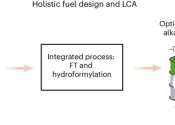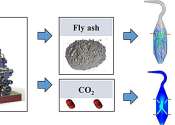Carbon dioxide (chemical formula: CO2) is a chemical compound composed of two oxygen atoms covalently bonded to a single carbon atom. It is a gas at standard temperature and pressure and exists in Earth's atmosphere in this state.
Carbon dioxide is used by plants during photosynthesis to make sugars, which may either be consumed in respiration or used as the raw material to produce other organic compounds needed for plant growth and development. It is produced during respiration by plants, and by all animals, fungi and microorganisms that depend either directly or indirectly on plants for food. It is thus a major component of the carbon cycle. Carbon dioxide is generated as a by-product of the combustion of fossil fuels or the burning of vegetable matter, among other chemical processes. Large amounts of carbon dioxide are emitted from volcanoes and other geothermal processes such as hot springs and geysers and by the dissolution of carbonates in crustal rocks.
As of March 2009[update], carbon dioxide in the Earth's atmosphere is at a concentration of 387 ppm by volume. Atmospheric concentrations of carbon dioxide fluctuate slightly with the change of the seasons, driven primarily by seasonal plant growth in the Northern Hemisphere. Concentrations of carbon dioxide fall during the northern spring and summer as plants consume the gas, and rise during the northern autumn and winter as plants go dormant, die and decay. Carbon dioxide is a greenhouse gas as it transmits visible light but absorbs strongly in the infrared and near-infrared.
Carbon dioxide has no liquid state at pressures below 5.1 atmospheres. At 1 atmosphere (near mean sea level pressure), the gas deposits directly to a solid at temperatures below −78 °C and the solid sublimes directly to a gas above −78 °C. In its solid state, carbon dioxide is commonly called dry ice.
CO2 is an acidic oxide: an aqueous solution turns litmus from blue to pink. It is the anhydride of carbonic acid, an acid which is unstable and is known to exist only in aqueous solution.
CO2 is toxic in higher concentrations: 1% (10,000 ppm) will make some people feel drowsy. Concentrations of 7% to 10% cause dizziness, headache, visual and hearing dysfunction, and unconsciousness within a few minutes to an hour.









